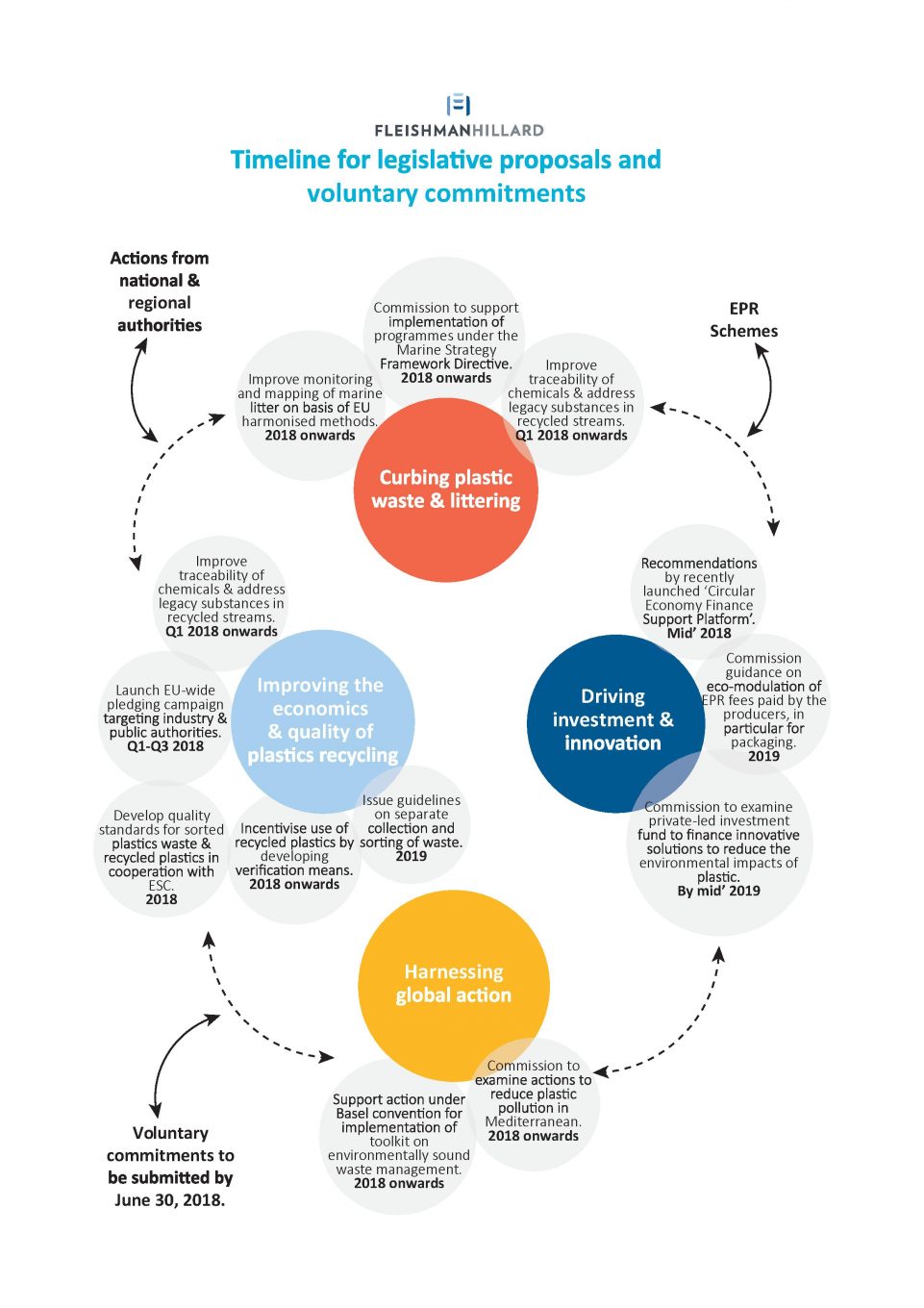On Tuesday, January 30th, FleishmanHillard hosted its Plastics Strategy roundtable in a very timely manner given that the strategy was published just two weeks before. The Plastics Strategy plays a key role in the broader Circular Economy package from December 2015 and seems to be on top of many people’s minds at the moment
The Commission’s vision, as set out in the Strategy, is to move towards “a smart, innovative and sustainable plastics industry, where design and production fully respect the needs of reuse, repair, and recycling, brings growth and jobs to Europe and helps cut EU’s greenhouse gas emissions and dependence on imported fossil fuels”. As also confirmed by Commission officials, it is certainly not intended to be seen as an “anti-plastic” Strategy. On the contrary, the objective is to improve the image of plastics. The Plastics Strategy tries to substantiate this and turn the Commission’s vision into reality by proposing a set of 39 EU actions.
During the FH roundtable with Mr Schally, Head of Unit DG ENV.B1 for Sustainable Production, Products and Consumption, moderated by former MEP Chris Davies, industry stakeholders had the opportunity to gain a first-hand insight into the Commission’s thinking, to share initial feedback and raise questions. While there were many interesting points raised during this discussion, we have summarized our three main takeaways from that day:
- Single-use plastics: While not mentioned very explicitly in the Plastics Strategy, the Commission recently launched a public consultation on possible legislation restricting single-use plastics. There are still many questions regarding the scope of such an instrument and the definition of what a single-use plastic actually is. To this, it seems that the main challenge confronting the Commission at the moment is being able to establish the impact assessment in the short time before May and to take into consideration the contributions from the public consultation. The Commission is keen to have the legislation in place before the end of its mandate but in order to do so, it would have to come out in the coming months.
- Cost-effective recycling and definition of “recyclable”: The Commission lays out its ‘vision for Europe’s new plastics economy’ in the Strategy, partially by writing that, “by 2030, all plastics packaging placed on the EU market is either reusable or can be recycled in a cost-effective manner.” However, the document is lacking any definition as to what a “cost-effective manner” actually is. In principle, most plastic materials could be recycled. However, the big question is whether recycling is always the most efficient option. At least there seems agreement that recycling should not be the goal in itself but one of the means to achieve the goal of moving towards a circular economy.
- Voluntary commitments: the Strategy calls on industry players to step forward with voluntary commitments to ensure that by 2025 ten million tonnes of recycled plastics find their way into new products on the EU market. Of note is that all submitted commitments will be put under quality check, and assessed against their reliability and ability to meet the deadlines (further details are set out in Annex III). By the end of October, the Commission will present an assessment of the pledges received and if the contribution is deemed insufficient, it will start working on possible regulatory action. So stakeholders clearly get a chance to come forward with voluntary actions which may avoid regulation. However, certain questions are left unanswered; for instance, what types of voluntary commitments could be presented? How will the Commission determine whether their contribution is “sufficient”? What are the potential measures that the Commission foresees in case the commitments are “insufficient”?
While much emphasis is put on the role of industry as well as national and regional authorities, another pressing aspect of whether the Plastics Strategy will succeed lies in the hands of consumers. Plastic packaging is, for instance, a mode of plastic that consumers have daily contact with. If we are to track our progress, be it on a local, Member State, or EU level, in ridding our societies of unnecessary plastic waste, then an assessment must be made to see what the current demand for packaging is versus the amount of waste residing from such packaging. Here, consumer responsibility can only succeed once consumers critically assess the plastics they use. However, in order to hold consumers responsible, they must be provided with credible information and in an easily comprehensible manner in order to make smart decisions. Economic instruments, such as taxes or more positive incentives, may also play a role in addressing consumer consumption.
In conclusion, we believe that the Plastics Strategy largely feeds into the need for enhanced dialogue and cooperation across value chains. As other initiatives from the Circular Economy package have already shown, an integrated approach is essential to deal with these complex issues and to find innovative and sustainable solutions. Let the name of the Plastics Strategy not be misleading; this Strategy is not just about the plastics industry but will have an impact on the European economy and our daily lives. As Commission 1st Vice-President Frans Timmerman put it, “this is a challenge that citizens, industry and governments must tackle together.” FleishmanHillard’s Environment Team members will continue to actively engage on the Strategy and are looking forward to further support stakeholders in any related activities.

Find Out More
-
Generative AI is changing the search game
May 8, 2025
-
The challenges facing Europe and European leaders at Davos 2025
January 24, 2025


